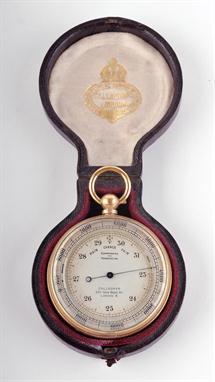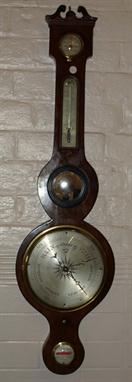60594 Preisdatenbank Los(e) gefunden, die Ihrer Suche entsprechen
60594 Lose gefunden, die zu Ihrer Suche passen. Abonnieren Sie die Preisdatenbank, um sofortigen Zugriff auf alle Dienstleistungen der Preisdatenbank zu haben.
Preisdatenbank abonnieren- Liste
- Galerie
-
60594 Los(e)/Seite
A brass surveyor`s sighting compass dial Potter, London, 19th century, The 4 inch circular silvered dial with foliate engraved eight-point compass rose with direction annotations and signed Potter, Poultry, London to centre within scale annotated in tens 0-90 for each quadrant and further raised scale calibrated 0-360, the pivoted steel pointer with locking arm, mounted on a shaped plate with extensions fitted with hinged opposing sighting arms each with tension line and hairline slot viewing apertures, 21cm (8.25ins) long, mounted via a ball and socket joint onto original mahogany tripod stand with two-part threaded legs. John Potter succeeded R.B. Bate who is recorded in Banfield BAROMETER MAKERS AND RETAILERS as working at 31 Poultry London up to 1849, Banfield records Potter as working from the same address 1850-84 and was appointed maker to the Lords Commissioners of the Admiralty.
A gilt brass aneroid pocket barometer/altimeter, J. Lizars, Glasgow, late 19th century, The silvered dial with blued steel pointer and adjustable bezel calibrated in feet around fixed inner scale calibrated in barometric inches and signed J. LIZARS GLASGOW. EDINBURGH ETC to centre, the watch-form case with knurled crown for adjusting the altimeter scale within the pivoted suspension loop, diam 5cm, in original leather covered outer case with trade label to inside of cover. John Lizars is recorded in Banfield, Edwin ??BAROMETER MAKERS AND RETAILERS 1660-1900 as working at various addresses in Glasgow from 1858.
A gilt brass aneroid pocket barometer/altimeter Callaghan, London, late 19th century, The silvered dial with blued steel pointer and adjustable bezel calibrated in feet around fixed inner scale calibrated in barometric inches and signed CALLAGHAN, 23A NEW BOND ST., LONDON. W. to centre, the watch-form case with pivoted suspension loop, diam 5cm, in original leather covered outer case with trade label to inside of cover. William Callaghan is recorded in Clifton, Gloria Directory of British Scientific Instrument Makers 1550-1851 as trading from 23A New Bond Street, London 1859-75.
A brass cased Naudet pattern aneroid `Holosteric` barometer with alcohol and mercury thermometers Unsigned, circa 1865, The 7 inch circular open-centred silvered register calibrated in barometric inches to upper section and mounted with alcohol and mercury Reaumur, Fahrenheit and Centigrade scale thermometers to lower section, the upper margin of the centre inscribed HOLOSTERIC BAROMETER and with serial number 5559 between the thermometer bulbs, the circular bevel glass fitted with a brass recording pointer retained in a moulded brass case with suspension loop, diameter 21cm. The current lot is an English version of the model produced by the firm of Naudet, Hulot & Cie in Paris after Vidie`s patent for the aneroid barometer had expired in 1859. A similar example by Edward George Wood of London was sold in these rooms The Banfield Collection of Barometers 4th September 2007 lot 18.
A rare oak cased laboratory micro-barograph, Negretti and Zambra, London, early 20th century. With two pairs of inter-connected eight-segment vacuum chambers mounted within a substantial frosted nickel-finish brass frame with armature operating the inked pointer for the 6 inch high clockwork-driven rotating recording drum, the base with applied plate inscribed MICRO-BAROGRAPH, NEGRETTI & ZAMBRA, R/31161 together with calibration parameter notes, under five-glass bevel glazed hinged cover with moulded skirt base incorporating chart drawer and on squab feet, 48cm (19ins) wide. The firm of Negretti and Zambra are recorded in Banfield, Edwin BAROMETER MAKERS AND RETAILERS 1660-1900 as being established in 1850 when a partnership between Enrico Negretti and Joseph Zambra was formed. The firm became one of the most prolific makers of scientific instruments and continued trading well into the 20th century. The current lot is designed to record relatively small variations in barometric pressure over a given time in order to provide accurate trends to assist in weather forecasting.
A Regency mahogany sympiesometer, Adie, Edinburgh, circa 1825, With glazed rectangular silvered scale applied with sulphuric acid and hydrogen gas filled syphon tube against a Fahrenheit temperature scale with a separate scale calibrated for the barometric inches adjusted via brass knob slider to the right-hand side of the case, to the left is a Fahrenheit scale mercury thermometer above inscription PATENT, Adie, Edinburgh with sector for the rotating recording disc with serial number No. 1286 beneath, the simple rectangular case with reeded moulded surround, 60cm high. Alexander Adie is recorded in Banfield, Edwin BAROMETER MAKERS AND RETAILERS 1660-1900 as born 1775 and dying in 1858. Adie was the nephew of John Miller, one of the leading Scottish makers of Scientific Instruments in the 18th century and was apprenticed to him in 1789. In 1804 they formed the partnership of Miller and Adie which continued until the death of John Miller in 1815. Adie continued the business alone specialising in meteorological instruments obtaining a patent in 1818 for his air barometer or sympiesometer. In recognition of this invention he was elected a Fellow of the Royal Society of Edinburgh in 1819. He was appointed optician to William IV and later Queen Victoria after forming a partnership with his son, John, in 1835. The sympiesometer was patented by Alexander Adie in 1818 and is essentially an improved version of Robert Hooke`s thermobarometer which he described in a paper presented to the Royal Society in 1668. The hydrogen gas in the syphon tube is affected by both temperature and pressure so the instrument has to be first calibrated by adjusting the moveable barometric scale against the temperature calibrations so that the pointer lines up with the temperature reading on the mercury thermometer to the left of the syphon tube before a reading can be taken from the top of the fluid level. The sympiesometer was conceived as an alternative to the mercury marine barometer as it was smaller thus more portable.
A Dutch inlaid mahogany mercury contra-barometer J. Stopanni, Amsterdam, 19th century The two-section urn surmount outlined pewter scales with ribbon bow crest decorated signature cartouche above applied spirit Fahrenheit and Reaumur scale thermometer to the left hand scale, the centre tube flanked by scales for both English and French barometric inches, the right hand main scale annotated with additional amplified English barometric inches incorporating the Dutch `36` scale calibrated 20-0-16 with the 0 representing the mean pressure at sea level in The Netherlands, the case with parquetry banded broken triangular pediment and vase finial above chevron banded frieze panel and glazed front door with conforming inlay to surround, the box base with three half bell-shaped inserts and two vase shaped pendant finials, 127cm high overall.
A Victorian mother-of-pearl inlaid rosewood mercury wheel barometer, Gardiner, Glasgow, mid 19th century. The 8 inch terrestrial sphere centred circular silvered register calibrated in barometric inches and with the usual observations beneath bowfronted alcohol Fahrenheit scale thermometer and hygrometer to the swan neck pediment, the square base with rectangular spirit level signed GARDINER, GLASGOW, the case with fine mother-of-pearl foliate marquetry borders and cavetto moulded underside to base, 98cm high.
A Regency mahogany mercury wheel barometer, P. Lyon, South Molton, early 19th century. The 8 inch star-centre engraved circular silvered register calibrated in inches beneath convex mirror and arched Fahrenheit scale spirit thermometer and hygrometer to the swan neck pediment, the rounded base with spirit level signed P. LYON, SOUTH MOLTON and with recording pointer adjustment square, the case with ebony and box wood lined edges, 97cm. Provenance: The late Mr Michael Stoop.
*An unusual George III mahogany and burr elm domestic striking regulator of one week duration with centre seconds. Alexander Cumming, Inveraray, late 18th century. The substantial five pillar rack striking movement with deadbeat escapement, bolt-and-shutter maintaining power and six wheel going train, the backplate with aperture cut for the pallets and with wood-rod pendulum with heavy brass faced lenticular bob, the 12 inch square single sheet silvered brass Roman numeral dial with blued steel hands and signed Ale:r Cumming INVERARAY to an arched cartouche to centre within chapter ring with Arabic five minutes to outer track and fine scallop shell inhabited foliate scroll engraved decoration to spandrels, in a case with moulded cornice and turned columns to hood above burr elm veneered panel inset break-arch door to trunk, on plinth base veneered with conforming rectangular panel, on bracket feet, 207cm (81.5ins) high. Alexander Cumming was born circa 1732 and was working with his brother, John, in Inveraray by 1752. He was a founder member of the Scottish Royal Society in Edinburgh and by 1761 he had moved to London. Cumming was subsequently appointed as an `expert` by Act of Parliament to assess Harrison`s marine timekeepers, and in 1763 supplied the first ever recording barometer to George III which is still in the Royal Collection at Buckingham Palace. In 1766 he published The Elements of Clock and Watch Work, he died in 1814. The current lot is an interesting early example of Cumming`s work and is perhaps a little experimental in nature. The six-wheel going train is unusual and was perhaps designed to remove errors in relation to its interaction with the strike train by delivering a high degree of power through the motionwork.
A William III brass lantern clock with ten inch square brass dial, Daniel Quare, London, circa 1695. The posted countwheel bell-striking movement with column turned corner uprights and now with anchor escapement, the 10 inch square brass dial with matted centre within an applied silvered Roman numeral chapter ring with stylised sword hilt half hour markers and signed Dan Quare, London to lower edge, with original steel hand and angles applied with winged cherub head and scroll cast spandrels, the frame with foliate pierced side frets and vase turned finials beneath domed bell bearer above, with rear hanging hoop and spurs to the turned ball feet, (lacking one side door and alarm) 40cm (16.75ins) high. Daniel Quare was admitted as Brother of the Clockmakers` Company in April 1671 and by 1683 he was working from Exchange Alley, London. He was selected as a member of the Court of Asssistants in 1698, later becoming Master in 1708. The following year he took a former apprentice, Stephen Horseman, into partnership which presumably lasted until Quare`s death in 1724. He was a fine inventive and commercially-minded maker who supplied clocks to significant European Royal and Aristocratic clients as well the Court of William III. As a Quaker, Quare refused an invitation from George I to be appointed `Royal Clockmaker` as his beliefs would not allow him to undertake the Oath of Allegiance, however an informal arrangement was agreed where Quare had open access to the palace via the back stairs. In addition to clocks, Quare is also famous for his `portable weather glass` or pillar barometer for which he sought a patent via the Clockmakers` Company in 1695. After his death in 1724 he was buried at the Quaker`s burial ground at Bunhill Fields.
A GEORGE IV MAHOGANY AND LINE INLAID BAROMETER the silvered dial engraved with a vase of flowers and with mercury thermometer, convex mirror in reeded ebonised slip, hygrometer and bubble level signed C Realini Preston, in fitted case with swan neck pediment, 108cm h ++ Reconditioned and restored with replacements, charged with mercury and ready to hang
-
60594 Los(e)/Seite










































